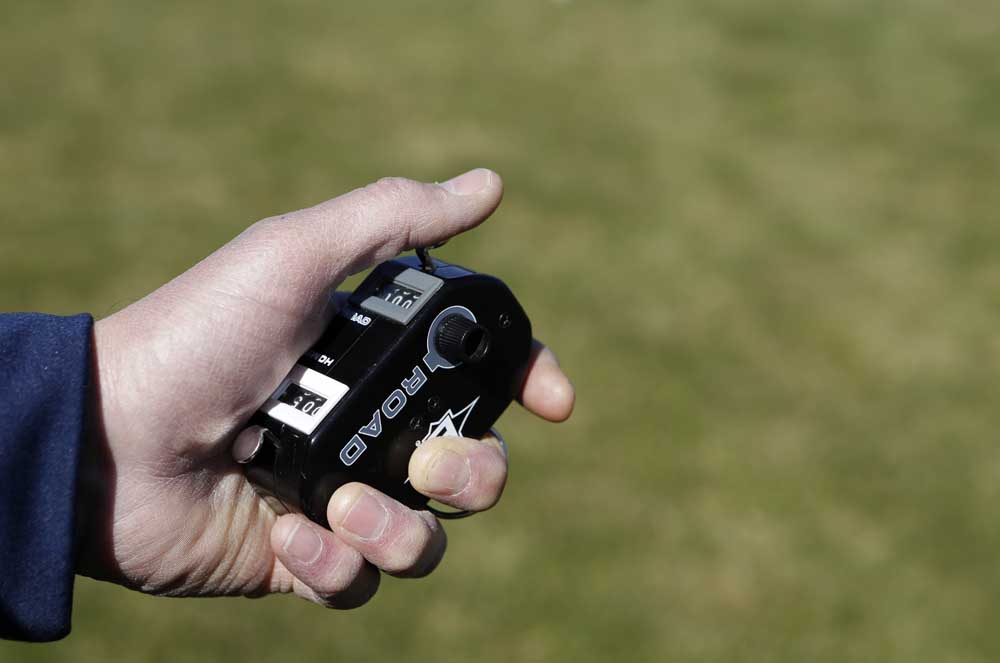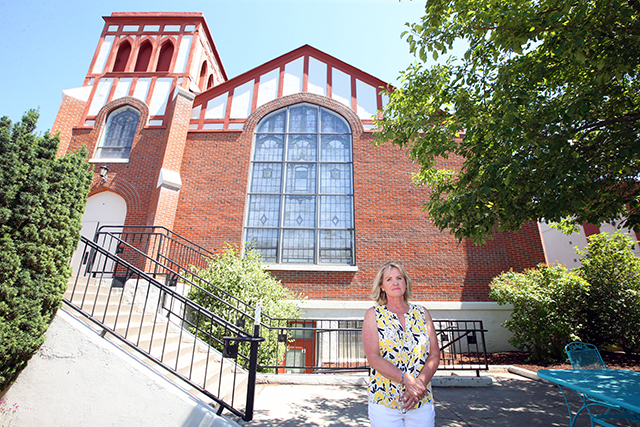Coaches, pitchers adapt to a new pitch count rule implemented by the OSAA
Published 12:00 am Tuesday, April 3, 2018

- Bend High pitching coach Chuck Clair demonstrates a pitch counter he uses at Bend High School on Monday.
At Bend High, each baseball player has two positions: wherever the coach tells him to play, and pitcher.
“That’s the way it’s been for the last 10 years I’ve been with the program,” says first-year Bend head coach Kevin Cooper.
Trending
That strategy is to help Cooper and his staff potentially discover hidden gems, such as a player with a knuckleball in his repertoire, or a kid who can pitch from a three-quarter arm slot rather than straight over the top. Yet the most noteworthy result of such a program is pitching depth. This season, Bend has 16 players on its varsity roster. And as many as 11 of them could see time on the mound.
“We’ve got kids that can gobble up innings,” Cooper says. “We don’t like throwing kids 100-plus (pitches), and that was before the pitch counts came into play.”
Cooper is referring to 2016, when the National Federation of State High School Associations adopted a rule that mandated state associations to require pitching restriction policies based on the number of pitches thrown in a game. That year, the Oregon School Activities Association recommended that its member schools followed the rule. The OSAA officially put it into its books for 2017 and designates a specific amount of rest and recovery days according to how many pitches were thrown in a single game (see toolbox) lest a team get fined or wins be forfeited.
The rule forced coaches to rethink their approach to building pitching staffs. They became more focused on pitch counts and planning ahead and turned their attention more toward pitching efficiency than strikeouts.
“I’m pretty fortunate that my catcher calls my game for me,” says fifth-year La Pine coach Bo DeForest. “We had to have a conversation: ‘Hey, we can’t waste pitches anymore. We have to try to pitch strikes that are low and causing groundouts.’ You can’t really do the get up two strikes and throw a couple waste pitches and hope you strike them out.”
What the rule also did was create more urgency by coaches to develop pitching depth. Bend High, one of the largest schools in Class 5A and being reclassified to 6A next year, benefits from a large pool of talent, and the Lava Bears’ emphasis on pitching early in players’ high school careers results in the expansive pitching talent they enjoy today. At 3A La Pine, the pool of potential hurlers is not as vast.
Trending
Yet all 13 of the Hawks’ players have the same position listed on the team’s roster: pitcher. That, DeForest says, is intentional. Because all 13 can pitch. Madras coach Sam McCormick understands that thinking.
“If you can throw a ball, you should pitch, in our mind,” the fifth-year White Buffaloes coach says. “Or at least be able to go up and get some outs. Baseball’s a game when you’re playing back-to-back-to-back on a high school varsity baseball team. You’ve got anywhere from 11 to 15 guys. It’s not like when you go on to college or professional baseball when you have 12 pitchers-only (players). We try to get everyone to be able to throw and contribute in some way. Because sometimes, we have to call on them.”
The pitch-count rule came into play after research presented to the American Orthopaedic Society of Sports Medicine indicated that 15- to 19-year-olds made up 56.7 percent of all Tommy John elbow ligament reconstruction surgeries performed in the United States between 2007 and 2011, rising an average of 9.1 percent per year. Researchers said overuse and poor mechanics were primary causes for the troubling increase.
Taking the new rule into account has created added concern for Oregon high school coaches. They are out of necessity more aware of pitch counts these days than ever before — and becoming more creative with their pitching rotations.
“It turns into more of a chess game,” McCormick says. “You need to think about the game you’re in, sometimes. But you also have to think in the future. We have to do that right now, juggling who can throw tomorrow and then how many (pitches) can they throw? It makes it a little more tricky to manage your guys. But it’s also done in good faith. You don’t want to ruin kids’ arms by running them out and throwing 150 pitches a day.”
Certainly coaches were aware of pitch counts before the rule went into place. Now, however, DeForest is frequently checking his hand-held pitch counter and confirming his pitch total with the official scorebook.
“Any responsible coach should be pitching their kids early (in the season) with a maximum of 50 pitches,” the La Pine coach says. “We try to stay between 30 and 50 pitches at the beginning (of the season) and then slowly ramp it up. … Some of those pitch counts are a little extreme. But I guess it’s better to err on that side than on the other side.”
“It’s a pretty fair rule, knowing that young arms are important for the future of baseball,” says Bend senior right-hander Marshall Davis, who plans to play college ball. “I’m playing at the next level, so I want my arm to be healthy for next year, too, and the years after that.”
Obviously the pitch-count rule is about minimizing arm injuries to high school players. The management and usage of pitchers has become second nature for these Central Oregon coaches, who, in turn, have become decent chess players — such as Cooper at Bend, who often thinks several pitching moves ahead.
“No matter how good a kid is, even at the major league level, a third time through the (batting) order, inherently your batting average goes up because there’s a sense of comfortability,” Cooper says. “At the high school level, you’re only guaranteed three, maybe four at-bats. And if you’re seeing a different pitcher every single time, that makes it really hard to dig in.”
—Reporter: 541-383-0307, glucas@bendbulletin.com.








